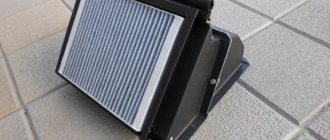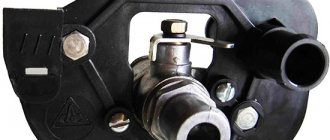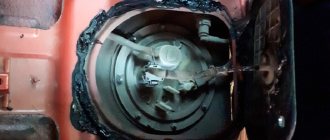Smell when turning on the heater in a car - causes and solutions.
This post has .
An unpleasant smell when turning on the heater in a car often greets drivers with the onset of cold weather. You should get rid of it immediately, without experimenting with basic means for deodorizing the air in the car interior.
How to remove unpleasant odor from a car heater
Fragrances and aerosols will perfectly freshen the air inside your car. But not for long. Literally after a while, when the stove is running, it will again begin to tickle the nostrils, being not just an irritant to the sense of smell, but also a threat to health.
There are two ways to solve the problem:
- • in a car service;
- • on one's own.
In the first case, the stove is cleaned by a master using a hardware method. In this case, a device is used that performs complete sanitization with a mixture of gases containing chlorine. With this approach, all microorganisms that have settled there in the air conditioning system die. The method is certainly effective, but somewhat expensive.
The cost of using the second method is zero, but it presupposes that the car owner has certain skills: knowledge of the components and assemblies of the car and the ability to apply them in practice.
The first step to cleaning the stove is replacing the cabin filter. After removing it, you need to wipe the place where it is located and the space around it, because... An impressive amount of dust usually collects here. Did not help? Does the smell reappear when you turn on the stove? So, look for the problem further.
Debris and dirt deposits may be in the furnace blower fan located in front of the filter. The skills and abilities mentioned above will be needed precisely in order to get to the indicated place - for this you will have to disassemble everything and even remove the dashboard, including the fan, fan box and box with the cabin evaporator.
The work is not easy, but for someone with experience it is not particularly difficult. After washing the box and desiccant, you need to dry them. The fan should be washed, paying special attention to the blades - a lot of dust accumulates on them. It's easy enough to blow out its internal parts. The evaporator is treated with an antibacterial agent purchased at any auto store.
After cleaning the insides and installing a new cabin filter, you can enjoy fresh, clean air while enjoying a comfortable and safe ride for your respiratory system.
Causes of unpleasant odor.
Where does the hated smell come from? Over time, harmful microorganisms (viruses, spores, mold, mildew) and pathogenic bacteria accumulate in the air conditioning system.
In addition, road dust, leftover leaves, small particles of debris, poplar fluff, etc. can get into the interior from the street. In the summer, moisture condenses on a running air conditioner, creating an ideal breeding ground for the formation of various microorganisms harmful to health. Plus, don’t forget about insects that can inexplicably get into the most inaccessible places. Over time, dying and decomposing, they can also cause an unfortunate smell.
What are the dangers of using a contaminated stove?
If there is no cabin filter or if it is not replaced in a timely manner, the air, passing through the dirt-clogged filter and the evaporator of the stove/air conditioner, enters the lungs of the driver and passengers in the cabin, saturating them with spores of pathogenic fungi. Therefore, for prevention, it is recommended to change the cabin filter once a year, depending on the intensity of use of the car, and regularly carry out antibacterial cleaning of the inside of the stove.
Possible consequences and solutions
The antifreeze leak problem has several negative consequences.
- Technical. A leak will sooner or later lead to a critical drop in the antifreeze level and engine overheating. The coolant in the cabin will lead to accelerated oxidation of the contacts of the on-board electronics, since antifreeze is partially composed of water. And if there is a large coolant leak, this problem can even cause a short circuit in the electrical wiring.
- Operational. Systematic fogging of windows due to condensation of antifreeze leaving the system will constantly reduce visibility. The risk of getting into an accident will increase. Excessive humidity in the cabin will lead to the appearance of fungus and mold. And this is an additional source of unpleasant odor.
- Physiological. Ethylene glycol, the main component of the vast majority of modern coolants, is toxic to humans. The lethal dose ranges from 100 to 300 grams. In volatile form, when ingested through the respiratory system, its concentration in the body rarely reaches a dangerous level. However, systematic inhalation of vapors may cause dizziness, nausea, coughing and irritation of the mucous membranes. In addition, the smell of antifreeze is not pleasant for everyone and can become an additional irritant.
The best solution in this situation is repair and replacement of damaged elements of the cooling system. As a temporary measure, it is possible to use repair sealant for the radiator.
to “Smell when turning on the heater in a car - causes and solutions.”
- Vladimir:
There was a similar problem quite recently. After two years of using the new car, an unpleasant odor appeared in the interior. At first I didn’t pay attention - I just hung up the “stinker”. But every day the smell intensified, it took on a putrid hue. I immediately realized that I would have to tinker with the glory. I removed the stove, washed it under running hot water and treated it with vinegar. I also had to remove the dashboard and wash all the air ducts with vinegar. The smell came from rotten leaves that fell between the gaps of the sabers under the windshield. To prevent this problem from recurring in the future, I glued the finest construction mesh to the sabers, after painting it black. I used epoxy resin as glue. Now the leaves do not fall into the cavities of the cabin filter and do not rot there. Also, instead of the standard paper filter, I installed a carbon cleaning element. Now there are no foreign odors in the car interior. I am calm about the health and safety of passengers.Answer
- Michael:
When I encountered a similar problem, I used a special solution to eliminate the unpleasant odor from the interior. I used such a drastic method because replacing the cabin filter with a new one did not help me. The smell was still present. And there was no foreign debris (leaves, dust, etc.) in the street air intake cavity. In these cases, it is only necessary to carry out antibacterial treatment of the ventilation and heating system. I didn’t buy expensive products or go to a service station, but took a more budget-friendly route. To do this, I bought a garden sprayer and 500 ml (5 bottles of 100 ml each) of a medical solution of chlorhexidine. Next, I poured the entire solution into the spray bottle, then pulled out the cabin filter from the box so that it would not prevent the solution from entering the air ducts. And after starting the car, I turned on the heater (the speed and temperature were set to the maximum positions). The solution was sprayed into the cabin filter box for 2 minutes. The car doors should be opened so that the solution that has not evaporated on the heater radiator can evaporate. As a result, this was the only way to overcome the unpleasant smell from the car’s stove. It is also worth considering that the chlorhexidine solution itself only works at an ambient temperature of more than 20 degrees.
Answer
Yura:
Hi Mikhail, what kind of spray bottle is this? Where should I pour the solution?
Answer
A fairly common problem, it is not new. Many people neglect this and change the filter when the smell really becomes unbearable and dusty, and they completely forget about cleaning. When I once worked at a service station, I had to tinker with cleaning the stove itself, but using the standard tools of the service station itself, this is done much better than doing it yourself. Blowing with antibacterial agents, then thermal blowing.
You can, of course, do it yourself, but the process is quite labor-intensive. First of all, change the filter and clean the air ducts. They also sell disinfectants that need to be sprayed inside the air intake; this is a preventive measure and should be used in the early stages. They dissolve various contaminants well and kill bacteria. Only after this is it necessary to clean the drainage under the evaporator. It is advisable to also check and clean it more often; all dirt comes out of it from the internal chambers.
Answer
I completely agree, in order to eliminate the cause of the smell, you need to solve the main problem, and not drown it out with various aromas. At one time I often bought used cars, so I know that such a procedure should have been carried out immediately after purchasing the car, along with changing the oil filters. You have to take care not only of the car, but also of yourself; it’s much more pleasant to breathe clean air!
Answer
Thanks for the article. The problem is known. I’ll say right away that I personally would choose a car service. But for those who don’t want to overpay, there are many ways. One of them is to take chlorhexidine and dilute it 2 to 1 with water. We take out the cabin filter and turn on the heater at full power and spray the entire bottle inside where the filter was. You can repeat it and the smell disappears. Cheap and cheerful. Give it a try.
Answer
- Gleb:
Strange way. If you open the cabin filter box, remove the filter, and turn the heater on to maximum, the heater will blow smoothly from this open box. How can you spray something there against a powerful air flow??
Answer
I change the cabin filter along with the oil and air filters when I change the engine oil) It’s better to be on the safe side and replace cheap parts all at once than to breathe in something unknown. Despite the frequent replacement of the stove filter, there is always a lot of dust, cobwebs, spiders and bees themselves!!! (we are not surprised, namely bees) and everything that is possible. I don't accept sprayers. I am a supporter of frequent replacement rather than using chemicals.
Answer
Three years ago I encountered this problem. I left late in the evening; I had to travel 600 km. After about 100 km, a smell appeared, which only intensified. It’s night, it’s -25 degrees outside. I was driving without a heater and was cold as a dog. But I couldn’t stop anywhere, because I had to go to work. It turned out that cleaning was required. Now I carry out this procedure constantly
Answer
I tried to remove the smell from the stove myself. I was able to do this to some extent, but to be honest, in the grand scheme of things, it was a waste of time! It is impossible to completely remove the microorganisms inside the stove on your own, which will gradually multiply again and the smell will return again with the same force. Don’t torture yourself and calmly take the car to a car service center. They will thoroughly clean the dirty stove, carry out chemical treatment, and if the car service is good, they will also give a guarantee for their work. In terms of money, it won’t be much more expensive than fighting the nasty smell from the stove yourself.
Answer
A familiar problem, after buying a new car, a couple of years later there was a strange smell. It turned out that the heater radiator was dirty. It’s a bit expensive to take it to a car service; I did the cleaning myself. Using special gloves, I cleaned the filter from scale, rust, insects and dust. Additionally, chemical treatment was used. Once completed, the smell disappeared and fresh air circulated.
Answer
On my Grant, the smell appeared immediately in the new car, the smell of burnt rubber. Moreover, in the cold season at minus temperatures there is no smell. In winter, without problems in any mode, the stove is odorless, as soon as it gets warmer outside the smell appears in all modes on the red scale.
Answer
The smell in the car when the heater is on, the same when I open the hood, the filter is new, it’s not clear why, but I’ll try to clean the heater radiator
Answer










